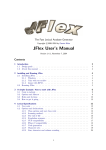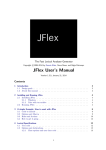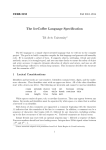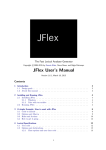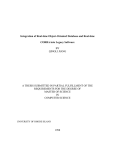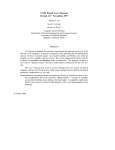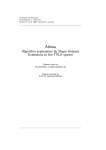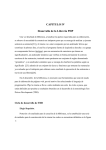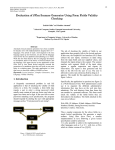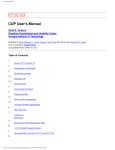Download JFlex User`s Manual
Transcript
JFlex User’s Manual
Version 1.2.2, August 23, 1999
Gerwin Klein
Contents
1 Introduction
3
1.1 Design goals . . . . . . . . . . . . . . . . . . . . . . . . . . . . . . . . . . . . .
3
1.2 About this manual . . . . . . . . . . . . . . . . . . . . . . . . . . . . . . . . .
3
2 Installing and Running JFlex
3
2.1 Installing JFlex . . . . . . . . . . . . . . . . . . . . . . . . . . . . . . . . . . .
3
2.2 Running JFlex . . . . . . . . . . . . . . . . . . . . . . . . . . . . . . . . . . . .
4
3 A simple Example: How to work with JFlex
5
3.1 Code to include . . . . . . . . . . . . . . . . . . . . . . . . . . . . . . . . . . .
7
3.2 Options and Macros . . . . . . . . . . . . . . . . . . . . . . . . . . . . . . . .
7
3.3 Rules and Actions . . . . . . . . . . . . . . . . . . . . . . . . . . . . . . . . . .
8
3.4 How to get it going . . . . . . . . . . . . . . . . . . . . . . . . . . . . . . . . .
10
4 Lexical Specifications
10
4.1 User code . . . . . . . . . . . . . . . . . . . . . . . . . . . . . . . . . . . . . .
10
4.2 Options and declarations . . . . . . . . . . . . . . . . . . . . . . . . . . . . . .
11
4.2.1 Class options and user class code . . . . . . . . . . . . . . . . . . . . .
11
4.2.2 Scanning method . . . . . . . . . . . . . . . . . . . . . . . . . . . . . .
12
4.2.3 The end of file . . . . . . . . . . . . . . . . . . . . . . . . . . . . . . .
13
4.2.4 Standalone scanners . . . . . . . . . . . . . . . . . . . . . . . . . . . .
14
4.2.5 CUP compatibility . . . . . . . . . . . . . . . . . . . . . . . . . . . . .
15
4.2.6 Code generation . . . . . . . . . . . . . . . . . . . . . . . . . . . . . .
15
1
4.2.7 Character sets . . . . . . . . . . . . . . . . . . . . . . . . . . . . . . . .
16
4.2.8 Line, character and column counting . . . . . . . . . . . . . . . . . . .
17
4.2.9 Obsolete JLex options . . . . . . . . . . . . . . . . . . . . . . . . . . .
17
4.2.10 State declarations . . . . . . . . . . . . . . . . . . . . . . . . . . . . .
17
4.2.11 Macro definitions . . . . . . . . . . . . . . . . . . . . . . . . . . . . . .
18
4.3 Lexical rules . . . . . . . . . . . . . . . . . . . . . . . . . . . . . . . . . . . . .
18
4.3.1 Syntax . . . . . . . . . . . . . . . . . . . . . . . . . . . . . . . . . . . .
18
4.3.2 Semantics . . . . . . . . . . . . . . . . . . . . . . . . . . . . . . . . . .
20
4.3.3 How the input is matched . . . . . . . . . . . . . . . . . . . . . . . . .
23
4.3.4 Scanner methods and variables accessible in actions . . . . . . . . . .
23
5 A few words on performance
25
5.1 Comparison of JLex and JFlex . . . . . . . . . . . . . . . . . . . . . . . . . . .
25
5.2 How to write a faster specification . . . . . . . . . . . . . . . . . . . . . . . .
27
6 Porting Issues
28
6.1 Porting from JLex . . . . . . . . . . . . . . . . . . . . . . . . . . . . . . . . . .
28
6.2 Porting from lex/flex . . . . . . . . . . . . . . . . . . . . . . . . . . . . . . . .
29
6.2.1 Basic structure . . . . . . . . . . . . . . . . . . . . . . . . . . . . . . .
29
6.2.2 Macros and Regular Expression Syntax . . . . . . . . . . . . . . . . . .
30
6.2.3 Lexical States . . . . . . . . . . . . . . . . . . . . . . . . . . . . . . . .
30
6.2.4 Lexical Rules . . . . . . . . . . . . . . . . . . . . . . . . . . . . . . . .
30
7 Working together: JFlex and CUP
31
7.1 CUP version 0.10j . . . . . . . . . . . . . . . . . . . . . . . . . . . . . . . . . .
31
7.2 Using existing JFlex/CUP specifications with CUP 0.10j . . . . . . . . . . . . .
31
7.3 Using older versions of CUP . . . . . . . . . . . . . . . . . . . . . . . . . . . .
32
8 Bugs and Deficiencies
34
8.1 Deficiencies . . . . . . . . . . . . . . . . . . . . . . . . . . . . . . . . . . . . .
34
8.2 Bugs . . . . . . . . . . . . . . . . . . . . . . . . . . . . . . . . . . . . . . . . .
34
9 Copying and License
34
2
1 Introduction
1
Introduction
JFlex is a lexical analyzer generator for Java1 written in Java. It is also a rewrite of the very
useful tool JLex [3] which was developed by Elliot Berk at Princeton University. As Vern
Paxon states for his C/C++ tool flex [5]: They do not share any code though.
1.1 Design goals
The main design goals of JFlex are:
Full unicode support
Fast generated scanners
Fast scanner generation
Convenient specification syntax
Platform independence
JLex compatibility
1.2 About this manual
This manual gives a brief but complete description of the tool JFlex. It assumes, that you are
familiar with the issue of lexical analysis. [2], [1] and [11] provide a good introduction to
this topic.
The next section of this manual describes installation procedures for JFlex. If you never
worked with JLex or just want to compare a JLex and a JFlex scanner specification you
should also read section 3. All options and the complete specification syntax are presented
in ‘‘Lexical specifications’’ (section 4). If you are interested in performance considerations
and comparing JLex vs. JFlex speed, ‘‘a few words on performance’’ (section 5) might be just
right for you. Those, who want to use their old JLex specifications may want to check out
section 6.1 to avoid possible problems with not portable or non standard JLex behavior that
has been fixed in JFlex. Section 6.2 talks about porting scanners from the Unix tools lex and
flex. Interfacing JFlex scanners with the LALR parser generator CUP is explained in section
7. Section 8 gives a list of currently known bugs. The manual continues with notes about
‘‘Copying and License’’ (section 9) and concludes with references.
2
Installing and Running JFlex
2.1 Installing JFlex
To install JFlex, follow these three steps:
1
Java is a trademark of Sun Microsystems, Inc., and refers to Sun’s Java programming language. JFlex is not
sponsored by or affiliated with Sun Microsystems, Inc.
3
2 Installing and Running JFlex
1. Unzip the file you downloaded into the directory you want JFlex in (using tar/unzip
for Unix or WinZip2 for W95/98). If you unzipped it to say C:\, the following directory
structure should be generated:
C:\JFlex\
+--bin\
+--doc\
+--examples\
+--java\
+--simple\
+--standalone\
+--lib\
+--src\
+--JFlex\
+--JFlex\gui
+--java_cup\runtime\
(start scripts)
(FAQ and this manual)
(Java 1.1 lexer specification)
(example scanner)
(a simple standalone scanner)
(the precompiled classes)
(source code of JFlex)
(source code of JFlex UI classes)
(source code of cup runtime classes)
2. Edit the file bin/jflex for Unix or bin\jflex.bat for W95/98 (in the example
above it’s C:\JFlex\bin\flex.bat) such that
JAVA HOME contains the directory where your Java JDK is installed (for instance
C:\java , such that C:\java\lib\classes.zip is the file of the standard
Java classes) and
JFLEX HOME the directory that contains JFlex (in the example: C:\JFlex )
3. Include the bin/ directory of JFlex in your path. (the one that contains the start scripts,
in the example: C:\JFlex\bin ).
2.2 Running JFlex
You run JFlex with:
jflex <options> <inputfiles>
If you have JDK 1.2, you can start up the JFlex GUI by a double click on the JAR-file.
It is also possible to skip steps 2 and 3 of the installation process and include the file
lib\JFlex.jar in your CLASSPATH environment variable instead.
Then you run JFlex with:
java JFlex.Main <options> <inputfiles>
The input files and options are in both cases optional. If you don’t provide a file name on the
commandline, JFlex will pop up a window to ask you for one.
JFlex knows about the following options:
-d <directory>
writes the generated file to the directory <directory>
2
http://www.winzip.com
4
3 A simple Example: How to work with JFlex
-skel <file>
uses external skeleton <file>. This is mainly for JFlex maintenance and special low
level customizations. Use only when you know what you are doing! JFlex comes with a
skeleton file in the src directory that reflects exactly the internal, precompiled skeleton
and can be used with the -skel option.
-verbose or -v
display generation progress messages (enabled by default)
-quiet or -q
display error messages only (no chatter about what JFlex is currently doing)
-time
display time statistics about the code generation process. (Not very accurate)
-help or -h
print a help message explaining options and usage of JFlex.
3
A simple Example: How to work with JFlex
To demonstrate what a lexical specification with JFlex looks like, this section presents a part
of the specification for the Java language. The example does not describe the whole lexical
structure of Java programs, but only a small and simplified part of it (some keywords, some
operators, comments and only two kinds of literals). It also shows how to interface with the
LALR parser generator CUP [8] and therefore uses a class sym (generated by CUP), where
integer constants for the terminal tokens of the CUP grammar are declared. JFlex comes with
a directory examples , where you can find a small standalone scanner that doesn’t need
other tools like CUP to give you a running example. The "examples " directory also contains
a complete JFlex specification of the lexical stucture of Java programs together with the CUP
parser specification for Java 1.1 by C. Scott Ananian, obtained from the CUP [8] website (it
was modified to interface with the JFlex scanner). Both specifications adhere strictly to the
Java Language Specification [7].
/* JFlex example: part of Java 1.0/1.1 language lexer specification */
import java_cup.runtime.*;
%%
%class Lexer
%unicode
%cup
%line
%column
%{
StringBuffer string = new StringBuffer();
5
3 A simple Example: How to work with JFlex
private Symbol symbol(int
return new Symbol(type,
}
private Symbol symbol(int
return new Symbol(type,
}
type) {
yyline, yycolumn);
type, Object value) {
yyline, yycolumn, value);
%}
LineTerminator = \r|\n|\r\n
InputCharacter = [ˆ\r\n]
WhiteSpace
= {LineTerminator} | [ \t\f]
/* comments */
Comment = {TraditionalComment} | {EndOfLineComment} | {DocumentationComment}
TraditionalComment
= "/*" [ˆ*] {CommentContent} "*"+ "/"
EndOfLineComment
= "//" {InputCharacter}* {LineTerminator}
DocumentationComment = "/**" {CommentContent} "*"+ "/"
CommentContent
= ( [ˆ*] | \*+ [ˆ/*] )*
Identifier = [:jletter:] [:jletterdigit:]*
DecIntegerLiteral = 0 | [1-9][0-9]*
%state STRING
%%
/* keywords
<YYINITIAL>
<YYINITIAL>
<YYINITIAL>
*/
"abstract"
"boolean"
"break"
<YYINITIAL> {
/* identifiers */
{Identifier}
{ return symbol(sym.ABSTRACT); }
{ return symbol(sym.BOOLEAN); }
{ return symbol(sym.BREAK); }
{ return symbol(sym.IDENTIFIER); }
/* literals */
{DecIntegerLiteral}
\"
{ return symbol(sym.INTEGER_LITERAL); }
{ string.setLength(0); yybegin(STRING); }
/* operators */
"="
"=="
"+"
{ return symbol(sym.EQ); }
{ return symbol(sym.EQEQ); }
{ return symbol(sym.PLUS); }
/* comments */
{Comment}
{ /* ignore */ }
/* whitespace */
{WhiteSpace}
{ /* ignore */ }
}
6
3 A simple Example: How to work with JFlex
<STRING> {
\"
[ˆ\n\r\"\]+
\\t
\\n
{ yybegin(YYINITIAL);
return symbol(sym.STRINGLITERAL,
string.toString()); }
{ string.append( yytext() ); }
{ string.append(’\t’); }
{ string.append(’\n’); }
\\r
\\"
\\
{ string.append(’\r’); }
{ string.append(’\"’); }
{ string.append(’\’); }
}
/* error fallback */
.|\n
{ throw new Error("Illegal character <"+
yytext()+">"); }
As with JLex, the specification consists of three parts, divided by %%:
usercode,
options and declarations and
lexical rules.
3.1 Code to include
Let’s take a look at the first section, ‘‘user code’’: The text up to the first line starting with %%
is copied verbatim to the top of the generated lexer class (before the actual class declaration).
Beside package and import statements there is usually not much to do here.
3.2 Options and Macros
The second section ‘‘options and declarations’’ is more interesting. It consists of a set of
options, code that is included inside the generated scanner class, lexical states and macro
declarations. Each JFlex option must begin a line of the specification and starts with a %. In
our example the following options are used:
%class Lexer tells JFlex to give the generated class the name ‘‘Lexer’’ and to write
the code to a file ‘‘Lexer.java ’’.
%unicode defines the set of characters the scanner will work on.
%cup switches to CUP compatibility mode to interface with a CUP generated parser.
%line switches line counting on (the current line number can be accessed via the
variable yyline)
%column switches column counting on (current column is accessed via yycolumn )
7
3 A simple Example: How to work with JFlex
The code included in %{...%} is copied verbatim into the generated lexer class source. Here
you can declare member variables and functions that are used inside scanner actions. In our
example we declare a StringBuffer ‘‘string’’ in which we will store parts of string literals
and two helper functions ‘‘symbol ’’ that create java cup.runtime.Symbol objects with
position information of the current token (see section 7 for how to interface with the parser
generator CUP). As JFlex options, both %{ and %} must begin a line.
The specification continues with macro declarations. Macros are abbreviations for regular
expressions, used to make lexical specifications easier to read and understand. A macro
declaration consists of a macro identifier followed by =, then followed by the regular
expression it represents. This regular expression may itself contain macro usages. Although
this allows a grammar like specification style, macros are still just abbreviations and not non
terminals -- they cannot be recursive or mutually recursive. Cycles in macro definitions are
detected and reported at generation time by JFlex.
Here some of the example macros in more detail:
LineTerminator stands for the regular expression that matches an ASCII CR, an
ASCII LF or an CR followed by LF.
InputCharacter stands for all characters that are not a CR or LF.
TraditionalComment is the expression that matches the string "/*" followed by a
character that is not a * followed by anything that matches the macro CommentContent followed by any number of * followed by /.
CommentContent matches zero or more occurrences of any character except a * or
any number of * followed by a character that is not a /
Identifier matches each string that starts with a character of class jletter followed
by zero or more characters of class jletterdigit . jletter and jletterdigit
are predefined character classes. jletter includes all characters for which the Java
function Character.isJavaIdentifierStart returns true and jletterdigit
all characters for that Character.isJavaIdentifierPart returns true.
The last part of the second section in our lexical specification is a lexical state declaration:
%state STRING declares a lexical state STRING that can be used in the ‘‘lexical rules’’ part
of the specification. A state declaration is a line starting with %state followed by a space
or comma separated list of state identifiers. There can be more than one line starting with
%state .
3.3 Rules and Actions
The "lexical rules" section of a JFlex specification contains regular expressions and actions
(Java code) that are executed when the scanner matches the associated regular expression.
As the scanner reads its input, it keeps track of all regular expressions and activates the action
of the expression that has the longest match. Our specification above for instance would
with input "breaker " match the regular expression for Identifier and not the keyword
"break" followed by the Identifier "er", because rule {Identifier} matches more of this
8
3 A simple Example: How to work with JFlex
input at once (i.e. it matches all of it) than any other rule in the specification. If two regular
expressions both have the longest match for a certain input, the scanner chooses the action
of the expression that appears first in the specification. In that way, we get for input "break"
the keyword "break" and not an Identifier "break".
Additional to regular expression matches, one can use lexical states to refine a specification.
A lexical state acts like a start condition. If the scanner is in lexical state STRING, only
expressions that are preceded by the start condition <STRING> can be matched. A start
condition of a regular expression can contain more than one lexical state. It is then matched
when the lexer is in any of these lexical states. The lexical state YYINITIAL is predefined
and is also the state in which the lexer begins scanning. If a regular expression has no start
conditions it is matched in all lexical states.
Since you often have a bunch of expressions with the same start conditions, JFlex allows the
same abbreviation as the Unix tool flex:
<STRING> {
expr1
{ action1 }
expr2
{ action2 }
}
means that both expr1 and expr2 have start condition <STRING> .
The first three rules in our example demonstrate the syntax of a regular expression preceded
by the start condition <YYINITIAL> .
<YYINITIAL> "abstract"
{ return symbol(sym.ABSTRACT); }
matches the input "abstract " only if the scanner is in its start state "YYINITIAL ".
When the string "abstract " is matched, the scanner function returns the CUP symbol
sym.ABSTRACT . If an action does not return a value, the scanning process is resumed
immediatly after executing the action.
The rules enclosed in
<YYINITIAL> {
...
}
demonstrate the abbreviated syntax and are also only matched in state YYINITIAL .
Of these rules, one may be of special interest:
\"
{ string.setLength(0); yybegin(STRING); }
If the scanner matches a double quote in state YYINITIAL we have recognized the start of a
string literal. Therefore we clear our StringBuffer that will hold the content of this string
literal and tell the scanner with yybegin(STRING) to switch into the lexical state STRING.
Because we do not yet return a value to the parser, our scanner proceeds immediately.
In lexical state STRING another rule demonstrates how to refer to the input that has been
matched:
[ˆ\n\r\"]+
{ string.append( yytext() ); }
The expression [ˆ\n\r\"]+ matches all characters in the input up to the next backslash
9
4 Lexical Specifications
(indicating an escape sequence such as \n), double quote (indicating the end of the string),
or line terminator (which must not occur in a string literal). The matched region of the input
is referred to with yytext() and appended to the content of the string literal parsed so far.
The last lexical rule in the example specification is used as an error fallback. It matches any
character in any state that has not been matched by another rule. It doesn’t conflict with any
other rule because it has the least priority (because it’s the last rule) and because it matches
only one character (so it can’t have longest match precendence over any other rule).
3.4 How to get it going
Install JFlex (see section 2)
If you have written your specification file (or chosen one from the examples directory),
save it (say under the name java-lang.flex ).
Run JFlex with
jflex java-lang.flex
JFlex should then report some progress messages about generating the scanner and
write the generated code to the directory of your specification file.
Compile the generated .java file and your own classes. (If you use CUP, generate
your parser classes first)
That’s it.
4
Lexical Specifications
As shown above, a lexical specification file for JFlex consists of three parts divided by a single
line starting with %%:
UserCode
%%
Options and declarations
%%
Lexical rules
In all parts of the specification comments of the form /* comment text */ and the Java
style end of line comments starting with // are permitted. JFlex comments do nest - so the
number of /* and */ should be balanced.
4.1 User code
The first part contains Usercode that is copied verbatim into the beginning of the source file
of the generated lexer before the scanner class is declared. As shown in the example above,
this is the place to put package declarations and import statements. It is possible, but not
considered as good Java programming style to put own helper class (such as token classes)
in this section. They should get their own .java file instead.
10
4 Lexical Specifications
4.2 Options and declarations
The second part of the lexical specification contains options to customize your generated
lexer (JFlex directives and Java code to include in different parts of the lexer), declarations
of lexical states and macro definitions for use in the third section ‘‘Lexical rules’’ of the lexical
specification file.
Each JFlex directive must be situated at the beginning of a line and starts with the % character.
Directives that have one or more parameters are described as follows:
%class "classname"
means that you start a line with %class followed by a space followed by the name of the
class for the generated scanner (the double quotes are not to be entered, see section 3).
4.2.1
Class options and user class code
These options regard the name, the constructor and related parts of the generated scanner
class.
%class "classname"
Tells JFlex to give the generated class the name "classname " and to write the
generated code to a file "classname.java ". If the -d <directory> command line
option is not used, the code will be written to the directory where the specification file
resides. If no %class directive is present in the specification, the generated class will
get the name "Yylex" and will be written to a file "Yylex.java ". There should be
only one %class directive in a specification.
%implements "interface 1"[, "interface 2", ..]
Makes the generated class implement the specified interfaces. If more than one
%implements directive is present, all the specified interfaces will be implemented.
%extends "classname"
Makes the generated class a subclass of the class ‘‘classname ’’. There should be only
one %extends directive in a specification.
%public
Makes the generated class public (the class is only accessible in its own package by
default).
%final
Makes the generated class final.
%abstract
Makes the generated class abstract.
%{
...
%}
11
4 Lexical Specifications
The code enclosed in %{ and %} is copied verbatim into the generated class. Here you
can define your own member variables and functions in the generated scanner. As all
options, both %{ and %} must start a line in the specification. If more than one class
code directive %{...%} is present, the code is concatenated in order of appearance in
the specification.
%init{
...
%init}
The code enclosed in %init{ and %init} is copied verbatim into the constructor of
the generated class. Here, member variables declared in the %{...%} directive can be
initialized. If more than one initializer option is present, the code is concatenated in
order of appearance in the specification.
%initthrow{
"exception1"[, "exception2", ...]
%initthrow}
or (on a single line) just
%initthrow "exception1" [, "exception2", ...]
Causes the specified exceptions to be declared in the throws clause of the constructor.
If more than one %initthrow{ ... %initthrow} directive is present in the
specification, all specified exceptions will be declared.
4.2.2
Scanning method
This section shows how the scanning method can be customized. You can redefine the name
and return type of the method and it is possible to declare exceptions that may be thrown
in one of the actions of the specification. If no return type is specified, the scanning method
will be declared as returning values of class Yytoken .
%function "name"
Causes the scanning method to get the specified name. If no %function directive
is present in the specification, the scanning method gets the name ‘‘yylex’’. This
directive overrides settings of the %cup switch. Please note that the default name of the
scanning method with the %cup switch is next token. Overriding this name might
lead to the generated scanner being implicitly declared as abstract , because it does
not provide the method next token of the interface java cup.runtime.Scanner.
It is of course possible to provide a dummy implemention of that method in the class
code section, if you still want to override the function name.
%integer
%int
Both cause the scanning method to be declared as of Java type int. Actions in the
specification can then return int values as tokens. The default end of file value
under this setting is YYEOF, which is a public static final int member of the
generated class.
12
4 Lexical Specifications
%intwrap
Causes the scanning method to be declared as of the Java wrapper type Integer .
Actions in the specification can then return Integer values as tokens. The default end
of file value under this setting is null.
%type "typename"
Causes the scanning method to be declared as returning values of the specified type.
Actions in the specification can then return values of typename as tokens. The
default end of file value under this setting is null. If typename is not a subclass of
java.lang.Object, you should specify another end of file value using the %eofval{
... %eofval} directive or the <<EOF>> rule. The %type directive overrides settings
of the %cup switch.
%yylexthrow{
"exception1"[, "exception2", ...
%yylexthrow}
]
or (on a single line) just
%yylexthrow "exception1" [, "exception2", ...]
The exceptions listed inside %yylexthrow{ ... %yylexthrow} will be declared in
the throws clause of the scanning method. If there is more than one %yylexthrow{
... %yylexthrow} clause in the specification, all specified exceptions will be
declared.
4.2.3
The end of file
There is always a default value that the scanning method will return when the end of file has
been reached. You may however define a specific value to return and a specific piece of code
that should be executed when the end of file is reached.
The default end of file values depends on the return type of the scanning method:
For %integer , the scanning method will return the value YYEOF, which is a public
static final int member of the generated class.
For %intwrap ,
no specified type at all, or a
user defined type, declared using %type, the value is null.
In CUP compatibility mode, using %cup, the value is
new java cup.runtime.Symbol(sym.EOF)
User values and code to be executed at the end of file can be defined using these directives:
%eofval{
...
%eofval}
13
4 Lexical Specifications
The code included in %eofval{ ... %eofval} will be copied verbatim into the
scanning method and will be executed each time when the end of file is reached (this
is possible when the scanning method is called again after the end of file has been
reached). The code should return the value that indicates the end of file to the parser.
There should be only one %eofval{ ... %eofval} clause in the specification. The
%eofval{ ... %eofval} directive overrides settings of the %cup switch. As of
version 1.2 JFlex provides a more readable way to specify the end of file value using
the <<EOF>> rule (see also section 4.3.2).
%eof{
...
%eof}
The code included in %{eof ...%eof} will be executed exactly once, when the end of
file is reached. The code is included inside a method void yy do eof() and should
not return any value (use %eofval{...%eofval} or <<EOF>> for this purpose). If
more than one end of file code directive is present, the code will be concatenated in
order of appearance in the specification.
%eofthrow{
"exception1"[,"exception2", ...
%eofthrow}
]
or (on a single line) just
%eofthrow "exception1" [, "exception2", ...]
The exceptions listed inside %eofthrow{...%eofthrow} will be declared in the
throws clause of the method yy do eof() (see %eof for more on that method). If
there is more than one %eofthrow{...%eofthrow} clause in the specification, all
specified exceptions will be declared.
%eofclose
Causes JFlex to close the input stream at the end of file. The code yyclose()
is appended to the method yy do eof() (together with the code specified in
%eof{...%eof} ) and the exception java.io.IOException is declared in the
throws clause of this method (together with those of %eofthrow{...%eofthrow})
4.2.4
Standalone scanners
%debug
Creates a main function in the generated class that expects the name of an input file on
the command line and then runs the scanner on this input file by printing each returned
token to the Java console until the end of file is reached.
%standalone
Creates a main function in the generated class that expects the name of an input file on
the command line and then runs the scanner on this input file. The values returned by
the scanner are ignored, but any unmatched text is printed to the Java console instead
14
4 Lexical Specifications
(as the C/C++ tool flex does, if run as standalone program). To avoid having to use
an extra token class, the scanning method will be declared as having default type int,
not YYtoken (if there isn’t any other type explicitly specified). This is in most cases
irrelevant, but could be useful to know when making another scanner standalone for
some purpose. You should also consider using the %debug directive, if you just want
to be able to run the scanner without a parser attached for testing etc.
4.2.5
CUP compatibility
You may also want to read section 7 if you are interested in how to interface your generated
scanner with CUP.
%cup
The %cup directive enables the CUP compatibility mode and is equivalent to the
following set of directives:
%implements java_cup.runtime.Scanner
%function next_token
%type java_cup.runtime.Symbol
%eofval{
return new java_cup.runtime.Symbol(sym.EOF);
%eofval}
%eofclose
4.2.6
Code generation
The following options define what kind of lexical analyzer code JFlex will produce. %pack is
the default setting and will be used, when no code generation method is specified.
%switch
With %switch JFlex will generate a scanner that has the DFA hard coded into a nested
switch statement. This method gives a good deal of compression in terms of the size of
the compiled .class file while still providing very good performance. If your scanner
gets to big though (say more than about 200 states) performance may vastly degenerate
and you should consider using one of the %table or %pack directives. If your scanner
gets even bigger (about 300 states), the Java compiler javac could produce corrupted
code, that will crash when executed or will give you an java.lang.VerifyError
when checked by the virtual machine. This is due to the size limitation of 64 KB of
Java methods as described in the Java Virtual Machine Specification [9]. In this case
you will be forced to use the %pack directive, since %switch usually provides more
compression of the DFA table than the %table directive.
%table
The %table direction causes JFlex to produce a classical table driven scanner that
encodes its DFA table in an array. In this mode, JFlex only does a small amount of
15
4 Lexical Specifications
table compression (see [6], [10], [1] and [11] for more details on the matter of table
compression) and uses the same method that JLex did up to version 1.2.1. See section
5 of this manual to compare these methods. The same reason as above (64 KB size
limitation of methods) causes the same problem, when the scanner gets too big. This
is, because the virtual machine treats static initializers of arrays as normal methods.
You will in this case again be forced to use the %pack directive to avoid the problem.
%pack
%pack causes JFlex to compress the generated DFA table and to store it in a string
literal. This string has to be unpacked when the first scanner object is created and
initialized. After unpacking, the internal access to the DFA table is exactly the same
as with option %table - the only extra work to be done at runtime is the unpacking
process which is quite fast (not noticable in normal cases), is done only once at startup,
and is in time complexity proportional to the size of the expanded DFA table. The
unpacking process is static, i.e. it is done only once for a certain scanner class - no matter
how often it is instantiated. Again, see section 5 on the performance of these scanners
With %pack, there should be practically no limitation to the size of the scanner. %pack
is the default setting and will be used, when no code generation method is specified.
4.2.7
Character sets
%7bit
Causes the generated scanner to expect 7 bit ASCII input files (character codes 0-127).
Because this is the default value in JLex, JFlex also defaults to 7 bit scanners. If an
input character with a code greater than 127 is encountered in an input at runtime,
the scanner will throw an ArrayIndexOutofBoundsException. Not only because
of this, you should consider using one of the %full or %unicode directives.
%full
%8bit
Both options cause the generated scanner to expect 8 bit ASCII input files (character
codes 0-255). If an input character with a code greater than 255 is encountered in an
input at runtime, the scanner will throw an ArrayIndexOutofBoundsException.
%unicode
%16bit
Both options cause the generated scanner to expect 16 bit Unicode input files (character
codes 0-65535). There will be no runtime overflow when using this set of input
characters.
%caseless
%ignorecase
This option causes JFlex to handle all characters and strings in the specification as if
they were specified in both uppercase and lowercase form. This enables an easy way to
specify a scanner for a language with case insensitive keywords. The string "break" in
a specificaion is for instance handled like the expression ([bB][rR][eE][aA][kK]).
16
4 Lexical Specifications
The %caseless option does not change the matched text and does not effect character classes. So [a] still only matches the character a and not A, too. Which
letters are uppercase and which lowercase letters, is defined by the Unicode standard
and determined by JFlex with the Java methods Character.toUpperCase and
Character.toLowerCase.
4.2.8
Line, character and column counting
%char
Turns character counting on. The int member variable yychar contains the number
of characters (starting with 0) from the beginning of input to the beginning of the
current token.
%line
Turns line counting on. The int member variable yyline contains the number of lines
(starting with 0) from the beginning of input to the beginning of the current token.
%column
Turns column counting on. The int member variable yycolumn contains the number
of characters (starting with 0) from the beginning of the current line to the beginning
of the current token.
4.2.9
Obsolete JLex options
%notunix
This JLex option is obsolete in JFlex but still recognized as valid directive. It used
to switch between W95 and Unix kind of line terminators (\r\n and \n) for the
$ operator in regular expressions. JFlex always recognizes both styles of platform
dependent line terminators.
%yyeof
This JLex option is obsolete in JFlex but still recognized as valid directive. In JLex it
declares a public member constant YYEOF. JFlex declares it in any case.
4.2.10 State declarations
State declarations have the following from:
%state "state identifier" [, "state identifier", ...
]
There may be more than one line of state declarations, each starting with %state. State
identifiers are letters followed by a sequence of letters, digits or underscores. State identifiers
can be separated by whitespace or comma.
The sequence
17
4 Lexical Specifications
%state STATE1
%state STATE3, XYZ, STATE 10
%state ABC STATE5
declares the set of identifiers STATE1, STATE3, XYZ, STATE 10, ABC, STATE5 as
lexical states.
4.2.11 Macro definitions
A macro definition has the form
macroidentifier = regular expression
That means, a macro definition is a macro identifier (letter followed by a sequence of letters,
digits or underscores), that can later be used to reference the macro, followed by optional
whitespace, followed by an "=", followed by optional whitespace, followed by a regular
expression (see section 4.3 for more information about regular expressions).
Each macro must fit on a single line.
The regular expression on the right hand side must be well formed and must not contain
the ˆ, / or $ operators. Differently to JLex, macros are not just pieces of text that are
expanded by copying - they are parsed and must be well formed.
This is a feature. It eliminates some very hard to find bugs in lexical specifications (such
like not having parentheses around more complicated macros - which is not necessary with
JFlex). See section 6.1 for more details on the problems of JLex style macros.
Since it is allowed to have macro usages in macro definitions, it is possible to use a
grammar like notation to specify the desired lexical structure. Macros however remain just
abbreviations of the regular expressions they represent. They are not non terminals of a
grammar and cannot be used recursively in any way. JFlex detects cycles in macro definitions
and reports them at generation time. JFlex also warns you about macros that have been
defined but never used in the ‘‘lexical rules’’ section of the specification.
4.3 Lexical rules
The ‘‘lexical rules’’ section of an JFlex specification contains a set of regular expressions
and actions (Java code) that are executed when the scanner matches the associated regular
expression.
4.3.1
Syntax
The syntax of the "lexical rules" section is described by the following BNF grammar (terminal
symbols are enclosed in ’quotes’):
LexicalRules ::= Rule+
Rule
::= [StateList] [’ˆ’] RegExp [LookAhead] Action
| [StateList] ’<<EOF>>’ Action
18
4 Lexical Specifications
StateGroup
StateList
LookAhead
Action
RegExp
|
::=
::=
::=
::=
StateGroup
StateList ’{’ Rule+ ’}’
’<’ Identifier (’,’ Identifier)* ’>’
’$’ | ’/’ RegExp
’{’ JavaCode ’}’ | ’|’
::=
|
|
|
|
|
|
|
|
|
RegExp ’|’ RegExp
RegExp RegExp
’(’ RegExp ’)’
RegExp (’*’|’+’|’?’)
RegExp "{" Number ["," Number] "}"
’[’ [’ˆ’] (Character|Character’-’Character)+ ’]’
PredefinedClass
’{’ Identifier ’}’
’"’ StringCharacter+ ’"’
Character
PredefinedClass ::=
|
|
|
|
|
|
’[:jletter:]’
’[:jletterdigit:]’
’[:letter:]’
’[:digit:]’
’[:uppercase:]’
’[:lowercase:]’
’.’
The grammar uses the following terminal symbols:
JavaCode
a sequence of BlockStatements as described in the Java Language Specification [7],
section 14.2.
Number
a non negative decimal integer.
Identifier
a letter [a-zA-Z] followed by a sequence of zero or more letters, digits or underscores
[a-zA-Z0-9_]
Character
an escape sequence or any unicode character that is not one of these meta characters:
| ( ) { } [ ] < > \ . * + ? ˆ $ / . "
StringCharacter
an escape sequence or any unicode character that is not one of these meta characters:
\ "
An escape sequence
– \n \r \t \f \b
19
4 Lexical Specifications
– a \x followed by two hexadecimal digits [a-fA-F0-9] (denoting a standard
ASCII escape sequence),
– a \u followed by four hexadecimal digits [a-fA-F0-9] (denoting an unicode
escape sequence),
– a backslash followd by a three digit octal number from 000 to 377 (denoting a
standard ASCII escape sequence), or
– a backslash followed by any other unicode character that stands for this character.
Please note, that the \n escape sequence stands for the ASCII LF character - not for the end
of line. If you want to match the end of line, you should use the expression \r|\n|\r\n to
take into account the different end of line standards on the platforms supported by Java.
As with version 1.1 of JFlex the whitespace characters " " (space) and "\t" (tab) can be
used to improve the readability of regular expressions. They will be ignored by JFlex. In
character classes and strings however, whitespace characters keep standing for themselfes
(so the string " " still matches exactly one space character and [ \n] still matches an ASCII
LF or a space character).
JFlex applies the following standard operator precedences in regular expression (from highest
to lowest):
unary operators (’*’,’+’,’?’, {n}, {n,m})
concatenation (RegExp::= RegExp Regexp)
union (RegExp::= RegExp ’|’ RegExp)
So the expression a | abc | cd* for instance is parsed as (a|(abc)) | (c(d*)) .
4.3.2
Semantics
This section gives an informal description of which text is matched by a regular expression
(i.e. an expression described by the RegExp production of the grammar presented above).
A regular expression that consists solely of
a Character matches this character.
a character class ’[’ (Character|Character’-’Character)+ ’]’ matches any
character in that class. A Character is to be considered an element of a class, if it
is listed in the class or if its code lies within a listed character range Character’’Character . So [a0-3\n] for instance matches the characters
a 0 1 2 3 \n
a negated character class ’[ˆ’ (Character|Character’-’Character)+ ’]’
matches all characters not listed in the class.
a string ’"’ StringCharacter+ ’" ’ matches the exact text enclosed in double
quotes. All meta characters but \ and " loose their special meaning inside a string.
20
4 Lexical Specifications
a macro usage ’{’ Identifier ’}’ matches the input that is matched by the right
hand side of the macro with name "Identifier ".
a predefined character class matches any of the characters in that class. There are the
following predefined character classes:
. contains all characters but \n.
All other predefined character classes are defined in the Unicode specification or the Java
Language Specification and determined by Java functions of class java.lang.Character.
[:jletter:]
[:jletterdigit:]
[:letter:]
[:digit:]
[:uppercase:]
[:lowercase:]
isJavaIdentifierStart()
isJavaIdentifierPart()
isLetter()
isDigit()
isUpperCase()
isLowerCase()
They are especially useful when working with the unicode character set.
If a and b are regular expressions, then
a | b (union) is the regular expression, that matches all input that is matched by a or by b.
a b (concatenation) is the regular expression, that matches the input matched by a followed
by the input matched by b.
a* (kleene closure) matches zero or more repetitions of the input matched by a
a+ is equivalent to aa*
a? matches the empty input or the input matched by a
a{n} is equivalent to n times the concatenation of a. So a{4} for instance is equivalent to
the expression a a a a. The decimal integer n must be positive.
a{n,m} is equivalent to at least n times and at most m times the concatenation of a. So a{2,4}
for instance is equivalent to the expression a a a? a?. Both n and m are non negative
decimal integers and m must not be smaller than n.
( a ) matches the same input as a.
In a lexical rule, a regular expression r may be preceded by a ’ˆ’ (the beginning of line
operator). r is then only matched at the beginning of a line in the input. A line begins after
each \r|\n|\r\n and at the beginning of input. The preceding line terminator in the input
is not consumed and can be matched by another rule.
In a lexical rule, a regular expression r may be followed by a lookahead expression. A
lookahead expression is either a ’$’ (the end of line operator) or a ’/’ followed by an
arbitrary regular expression. In both cases the lookahead is not consumed and not included
21
4 Lexical Specifications
int the matched text region, but it is considered while determining which rule has the longest
match (see also section 4.3.3).
In the ’$’ case r is only matched at the end of a line in the input. The end of a line is denoted
by the regular expression \r|\n|\r\n . So a$ is equivalent to a / \r|\n|\r\n
For arbitrary lookahead (also called trailing context) the expression is matched only when
followed by input that matches the trailing context. Unfortunately the lookahead expression
is not really arbitrary: In a rule r1 / r2, either the text matched by r1 must have a fixed
length (e.g. if r1 is a string) or the beginning of the trailing context r2 must not match
the end of r1. So for example "abc" / "a"|"b" is ok because "abc" has a fixed length,
"a"|"ab" / "x"* is ok because no prefix of "x"* matches a postfix of "a"|"ab" , but
"x"|"xy" / "yx" is not possible, because the postfix "y" of "x"|"xy" is also a prefix of
"yx". JFlex will report such cases at generation time. The algorithm JFlex currently uses for
matching trailing context expressions is the one described in [1] (leading to the deficiencies
mentioned above).
As of version 1.2, JFlex allows lex/flex style <<EOF>> rules in lexical specifications. A rule
[StateList]
<<EOF>>
{ some action code }
is very similar to the %eofval directive (section 4.2.3). The difference lies in the optional
StateList that may precede the <<EOF>> rule. The action code will only be executed
when the end of file is read and the scanner is currently in one of the lexical states listed
in StateList . The same StateGroup (see section 4.3.3) and precedence rules as in the
‘‘normal’’ rule case apply (i.e. if there is more than one <<EOF>> rule for a certain lexical
state, the action of the one appearing earlier in the specification will be executed). <<EOF>>
rules override settings of the %cup option and should not be mixed with the %eofval
directive.
An Action consists either of a piece of Java code enclosed in curly braces or is the special |
action. The | action is an abbreviation for the action of the following expression.
Example:
expression1
expression2
expression3
|
|
{ some action }
is equivalent to the expanded form
expression1
expression2
expression3
{ some action }
{ some action }
{ some action }
They are useful when you work with trailing context expressions. The expression a | (c /
d) | b is not syntactically legal, but can easily be expressed using the | action:
a
c / d
b
|
|
{ some action }
22
4 Lexical Specifications
4.3.3
How the input is matched
When consuming its input, the scanner determines the regular expression that matches
the longest portion of the input (longest match rule). If there is more than one regular
expression that matches the longest portion of input (i.e. they all match the same input),
the generated scanner chooses the expression that appeares first in the specification. After
determining the active regular expression, the associated action is executed. If there is no
matching regular expression, the scanner terminates the program with an error message
(if the %standalone directive has been used, the scanner prints the unmatched input to
java.lang.System.out instead and resumes scanning).
Lexical states can be used to further restrict the set of regular expressions that match the
current input.
A regular expression can only be matched when its associated set of lexical states
include the currently active lexical state of the scanner or if the set of associated lexical
states is empty.
The currently active lexical state of the scanner can be changed from within an action
of a regular expression using the method yybegin() .
The scanner starts in lexical state YYINITIAL , which is always declared by default.
The set of lexical states associated with a regular expression is calculated as follows:
The set of lexical states of a rule of the form
StateList RegExp Action
is the union of the set of all states listed in StateList and the set of lexical states of
the enclosing StateGroup , or just the set of all states in StateList , if there is no
enclosing StateGroup .
The set of lexical states of a state group of the form
StateList "{" Rule+ "}"
is the union of the set of all states listed in StateList and the set of lexical states
of the enclosing StateGroup , or just the set of all states in StateList, if there is no
enclosing StateGroup .
In short: lexical states cumulate over StateGroups .
Lexical states are declared and used as Java int constants in the generated class under
the same name as they are used in the specification.
4.3.4
Scanner methods and variables accessible in actions
The following methods and member variables of the generated scanner class are meant to be
accessed by the user in lexical actions:
String yytext()
returns the matched input text region
23
4 Lexical Specifications
int yylength()
returns the length of the matched input text region (does not require a String object
to be created)
void yyclose()
closes the input stream. All subsequent calls to the scanning method will return the
end of file value
int yystate()
returns the current lexical state of the scanner.
void yybegin(int lexicalState)
enters the lexical state lexicalState
void yypushback(int number)
pushes number characters of the matched text back into the inputstream. They will
be read again in the next call of the scanning method. The number of characters to
be read again must not be greater than the length of the matched text. The pushed
back characters will after the call of yypushback not be included in yylength and
yytext() . Please note, that in Java strings are unchangable, i.e. an action code like
String matched = yytext();
yypushback(1);
return matched;
will return the whole matched text, while
yypushback(1);
return yytext();
will return the matched text minus the last character.
int yyline
contains the current line of input (starting with 0, only active whith the %line
directive)
int yychar
contains the current character count in the input (starting with 0, only active whith the
%char directive)
int yycolumn
contains the current column of the current line (starting with 0, only active whith the
%column directive)
24
5 A few words on performance
5
A few words on performance
This section gives some empirical results about the speed of JFlex generated scanners in
comparison to those generated by JLex, compares a JFlex scanner with a handwritten one,
and presents some tips on how to make your specification produce a faster scanner.
5.1 Comparison of JLex and JFlex
Scanners generated by the tool JLex are quite fast. It was however possible to further improve
the performance of generated scanners using JFlex. The following table shows the results
that were produced by the scanner specification of a small toy programming language (in
fact the example from the JLex website). The scanner was generated using JLex and all three
different JFlex code generation methods. Then it was run on a W95 system using JDK 1.2
with different sample inputs of that toy programming language. All test runs were made
under the same conditions on an idle machine. The values presented in the table denote the
time from the first call to the scanning method to returning the EOF value and the speedup
in percent.
19050 lines, JIT
10010 lines, JIT
4982 lines, JIT
19050 lines, no JIT
10010 lines, no JIT
4982 lines, no JIT
JLex
1.73 s
0.63 s
0.3 s
8.37 s
3.2 s
1.58 s
%switch
1.62 s
0.57 s
0.27 s
7.92 s
2.99 s
1.47 s
speedup
6.3 %
9.8 %
8.0 %
5.7 %
7.0 %
7.5 %
%table
1.63 s
0.57 s
0.27 s
7.97 s
2.99 s
1.47 s
speedup
6.2 %
9.8 %
8.0 %
5.0 %
7.0 %
7.5 %
%pack
1.62 s
0.58 s
0.27 s
7.94 s
2.99 s
1.47 s
speedup
6.3 %
7.6 %
8.0 %
5.4 %
7.0 %
7.5 %
Since the scanning time of the lexical analyzer examined in the table above includes lexical
actions that often need to create new object instances, another table shows the execution
time for the same specification with empty lexical actions.
19050 lines, JIT
10010 lines, JIT
4982 lines, JIT
19050 lines, no JIT
10010 lines, no JIT
4982 lines, no JIT
JLex
0.56 s
0.24 s
0.12 s
5.74 s
2.27 s
1.14 s
%switch
0.46 s
0.19 s
0.1 s
4.93 s
1.9 s
0.96 s
speedup
21.2 %
30.1 %
20.0 %
16.3 %
19.7 %
19.5 %
%table
0.46 s
0.19 s
0.1 s
4.97 s
1.92 s
0.96 s
speedup
21.2 %
30.1 %
20.0 %
15.5 %
18.2 %
19.5 %
%pack
0.46 s
0.19 s
0.11 s
4.98 s
1.91 s
0.96 s
speedup
21.7 %
30.1 %
9.1 %
15.3 %
18.9 %
19.5 %
Execution time of single instructions depend on the platform and the implementation of the
Java Virtual Machine the program is executed on. Therefore the tables above can not be used
as a reference to which code generation method of JFlex is the right one to choose in general.
The following table was produced by the same lexical specification and the same input on a
Linux system using JDK 1.1.7 with the tya JIT compiler.
With actions:
25
5 A few words on performance
19050 lines, JIT
10010 lines, JIT
4982 lines, JIT
19050 lines, no JIT
10010 lines, no JIT
4982 lines, no JIT
JLex
3.32 s
1.2 s
0.6 s
6.42 s
2.45 s
1.22 s
%switch
3.12 s
1.12 s
0.56 s
5.87 s
2.19 s
1.08 s
speedup
6.2 %
6.8 %
7.7 %
9.5 %
11.5 %
12.7 %
%table
3.11 s
1.11 s
0.55 s
5.99 s
2.23 s
1.14 s
speedup
6.5 %
7.9 %
8.9 %
7.1 %
9.5 %
6.8 %
%pack
3.11 s
1.12 s
0.55 s
6.0 s
2.23 s
1.1 s
speedup
6.6 %
7.4 %
8.5 %
7.0 %
9.7 %
10.4 %
Without actions:
19050 lines, JIT
10010 lines, JIT
4982 lines, JIT
19050 lines, no JIT
10010 lines, no JIT
4982 lines, no JIT
JLex
1.25 s
0.49 s
0.25 s
3.68 s
1.49 s
0.75 s
%switch
0.98 s
0.39 s
0.2 s
2.93 s
1.15 s
0.57 s
speedup
27.8 %
25.6 %
24.9 %
25.3 %
29.5 %
30.5 %
%table
0.99 s
0.39 s
0.21 s
2.98 s
1.17 s
0.58 s
speedup
26.4 %
24.0 %
19.4 %
23.5 %
27.8 %
28.9 %
%pack
1.03 s
0.41 s
0.2 s
2.99 s
1.17 s
0.58 s
speedup
20.9 %
20.0 %
20.6 %
22.9 %
27.5 %
28.7 %
Although all JFlex scanners were faster than those generated by JLex, slight differences
between JFlex code generation methods show up when compared to the run on the W95
system.
The following table compares a handwritten scanner for the Java language obtained from
the website of CUP with the JFlex generated scanner for Java that comes with JFlex in the
examples directory. They were tested on different .java files on a Linux JDK 1.1.7 and
the tya JIT compiler.
6350 lines, JIT
492 lines, JIT
113 lines, JIT
6350 lines, no JIT
492 lines, no JIT
113 lines, no JIT
handwritten scanner
3.55 s
0.23 s
134 ms
6.28 s
0.41 s
201 ms
JFlex generated scanner
1.27 s
179 % faster
86 ms
167 % faster
37 ms
262 % faster
3.04 s
106 % faster
209 ms
96 % faster
81 ms
148 % faster
As you can see, the generated scanner is up to 2.5 times faster than the handwritten one. One
example of a handwritten scanner that is considerably slower than the equivalent generated
one is surely no proof for all generated scanners being faster than handwritten. It is clearly
impossible to prove something like that, since you could always write the generated scanner
by hand. From a software engineering point of view however, there is no excuse for writing
a scanner by hand since this task takes more time, is more difficult and therefore more error
prone than writing a compact, readable and easy to change lexical specification. (I like to
add, that I do
think, that the handwritten scanner from the CUP website used here in the
test is stupid or badly written or anything like that. I actually think, Scott did a great job with
it, and that for learning about lexers it is quite valuable to study it or even to write a similar
one for oneself.)
26
5 A few words on performance
5.2 How to write a faster specification
Although JFlex generated scanners show good performance without special optimizations,
there are some heuristics that can make a lexical specification produce an even faster scanner.
Those are (roughly in order of performance gain):
Avoid rules that require backtracking
From the C/C++ flex [5] manpage: ‘‘Getting rid of backtracking is messy and often may
be an enormous amount of work for a complicated scanner.’’ Backtracking is introduced
by the longest match rule and occurs for instance on this set of expressions:
"averylongkeyword"
.
With input "averylongjoke" the scanner has to read all charcters up to ’j’ to
decide that rule . should be matched. All characters of "verylong" have to be read
again for the next matching process. Backtracking can be avoided in general by adding
error rules that match those error conditions
"av"|"ave"|"avery"|"averyl"|..
While this is impractical in most scanners, there is still the possiblity to add a ‘‘catch
all’’ rule for a lengthy list of keywords
"keyword1"
..
"keywordn"
[a-z]+
{ return symbol(KEYWORD1); }
{ return symbol(KEYWORDn); }
{ error("not a keyword"); }
Most programming language scanners already have a rule like this for some kind of
variable length identifiers.
Avoid line and column counting
It costs one additional comparison per input character and the matched text has to be
rescanned for counting. In most scanners it is possible to do the line counting in the
specification by incrementing yyline each time a line terminator has been matched.
Column counting could also be included in actions. This will be faster, but can in some
cases become quite messy.
Avoid lookahead expressions and the end of line operator ’ ’
The trailing context will first have to be read and then (because it is not to be consumed)
read again.
Avoid the beginning of line operator ’ˆ’
It costs two additional comparisons per match. In some cases one extra lookahead
character is needed (when the last character read is \r the scanner has to read one
character ahead to check if the next one is an \n or not).
Match as much text as possible in a rule.
One rule is matched in the innermost loop of the scanner. After each action some
overhead for setting up the internal state of the scanner is necessary.
27
6 Porting Issues
Note, that writing more rules in a specification does not make the generated scanner slower
(except when you have to switch to another code generation method because of the larger
size).
The two main rules of optimization apply also for lexical specifications:
1. don’t do it
2. (for experts only) don’t do it yet
Some of the performance tips above contradict a readable and compact specification style.
When in doubt or when requirements are not or not yet fixed: don’t use them - the
specification can always be optimized in a later state of the development process.
6
Porting Issues
6.1 Porting from JLex
JFlex was designed to read old JLex specifications unchanged and to generate a scanner
which behaves exactly the same as the one generated by JLex with the only difference of
being faster.
This works as expected on all well formed JLex specifications.
Since the statement above is somewhat absolute, let’s take a look at what ‘‘well formed’’
means here. A JLex specification is well formed, when it
generates a working scanner with JLex
doesn’t contain the ’ˆ’ operator
The beginning of line operator has a non standard behavior in JLex: It consumes a
preceding \n character. This does not happen in JFlex generated scanners. The problem
can be worked around by writing an extra rule that matches the ‘‘new’’ \n characters.
doesn’t contain the ’$’ operator
The end of line operator is not platform independent in JLex. It matches a \n by
default or a \r\n when the %notunix directive is given. JFlex matches the expression
\r|\n|\r\n for the end of line and ignores the %notunix directive. This should
usually cause no problems with your old specification other than that it accepts other
platforms too.
doesn’t contain the %cup switch
The %cup switch has currently no meaning in JLex (this refers to JLex version 1.2.4, it
is anticipated that future versions of JLex will support the %cup switch with a similar
meaning as now in JFlex). In JFlex it is used to interface with CUP.
has only complete regular expressions surrounded by parentheses in macro definitions
This may sound a bit harsh, but could otherwise be a major problem -- it can also help
you find some disgusting bugs in your specification that didn’t show up in the first
28
6 Porting Issues
place. In JLex, a right hand side of a macro is just a piece of text, that is copied to the
point where the macro is used. With this, some weird kind of stuff like
macro1 = ("hello"
macro2 = {macro1})*
was possible (with macro2 expanding to ("hello")* ). This is not allowed in JFlex
and you will have to transform such definitions. There are however some more subtle
kinds of errors that can be introduced by JLex macros. Let’s consider a definition like
macro = a|b and a usage like {macro}* . This expands in JLex to a|b* and not to
the probably intended (a|b)* .
JFlex uses always the second form of expansion, since this is the natural form of
thinking about abbreviations for regular expressions.
Most specifications shouldn’t suffer from this problem, because macros often only
contain (harmless) character classes like alpha = [a-zA-Z] and more dangerous
definitions like
ident = {alpha}({alpha}|{digit})*
are only used to write rules like
{ident}
{ .. action .. }
and not more complex expressions like
{ident}*
{ .. action .. }
where the kind of error presented above would show up.
6.2 Porting from lex/flex
This section tries to give an overview of activities and possible problems when porting a
lexical specification from the C/C++ tools lex and flex [5] available on most Unix systems
to JFlex.
Most of the C/C++ specific features are naturally not present in JFlex, but most ‘‘clean’’
lex/flex lexical specifications can be ported to JFlex without very much work.
This section is by far not complete and is based mainly on a survey of the flex man page
and very little personal experience. If you do engage in any porting activity from lex/flex
to JFlex and encounter problems, have better solutions for points presented here or have
just some tips you would like to share, please do contact me via email: Gerwin Klein
<[email protected]> . I will incorporate your experiences in this manual (with all due credit to
you, of course).
6.2.1
Basic structure
A lexical specification for flex has the following basic structure:
29
6 Porting Issues
definitions
%%
rules
%%
user code
The user code section usually contains some C code that is used in actions of the rules
part of the specification. For JFlex most of this code will have to be included in the class
code %{..%} directive in the options and declarations section (after translating the
C code to Java, of course).
6.2.2
Macros and Regular Expression Syntax
The definitions section of a flex specification is quite similair to the options and
declarations part of JFlex specs.
Macro definitions in flex have the form:
<identifier>
<expression>
To port them to JFlex macros, just insert a = between <identifier> and <expression> .
The syntax and semantics of regular expressions in flex are pretty much the same as in JFlex.
A little attention is needed for some escape sequences present in flex (such as \a) that are
not supported in JFlex. These escape sequences should be transformed into their octal or
hexdecimal equivalent.
Another point are predefined character classes. Flex offers the ones directly supported by
C, JFlex offers the ones supported by Java. These classes will sometimes have to be listed
manually (if there is need for this feature, it may be implemented in a future JFlex version).
6.2.3
Lexical States
Flex supports two kinds of lexical states or start conditions: inclusive states declared with %s
and exclusive states declared using %x.
JFlex only supports inclusive lexical states (for which the %s just has to be replaced by
%state ).
6.2.4
Lexical Rules
Since flex ist mostly Unix based, the ’ˆ’ (beginning of line) and ’$’ (end of line) operators,
consider the \n character as only line terminator. This should usually cause not much
problems, but you should be prepared for \r or \r\n occurences that are now considered as
line terminators and therefore may not be consumed when ˆ or $ is present in a rule.
The trailing context algorithm of flex is better than the one used in JFlex. Therefore lookahead
expressions could cause major headaches. JFlex will issue an error message at generation
time, if it cannot generate a scanner for a certain lookahead expression. (sorry, I have no
30
7 Working together: JFlex and CUP
more tips here on that yet. If anyone knows how the flex lookahead algorithm works (or any
better one) and can be efficiently implemented, again: please contact me).
7
Working together: JFlex and CUP
One of the main design goals of JFlex was to make interfacing with the free Java parser
generator CUP [8] as easy as possibly. This has been done by giving the %cup directive a
special meaning. An interface however always has two sides. This section concentrates on
the CUP side of the story.
7.1 CUP version 0.10j
Since CUP version 0.10j, this has been simplified greatly by the new CUP scanner interface
java cup.runtime.Scanner. JFlex lexers now implement this interface automatically
when then %cup switch is used. There are no special parser code, init code or scan
with options any more that you have to provide in your CUP parser specification. You can
just concetrate on your grammar.
If your generated Lexer has the class name Scanner , the parser is started from the a main
program like this:
...
try {
parser p = new parser(new Scanner(new FileReader(fileName)));
Object result = p.parse().value;
}
catch (Exception e) {
...
7.2 Using existing JFlex/CUP specifications with CUP 0.10j
If you already have an existing specification and you would like to upgrade both JFlex and
CUP to their newest version, you will probably have to adjust your specification.
The main difference between the %cup switch in JFlex 1.2.1 and lower, and the current JFlex
version is, that JFlex scanners now automatically implement the java cup.runtime.Scanner
interface. This means, that the scanning function now changes its name from yylex() to
next token() .
The main difference from older CUP versions to 0.10j is, that CUP now has a default
constructor that accepts a java cup.runtime.Scanner as argument and that uses this
scanner as default (so no scan with code is necessary any more).
If you have an existing CUP specification, it will probably look somewhat like this:
parser code {:
Lexer lexer;
31
7 Working together: JFlex and CUP
public parser (java.io.Reader input) {
lexer = new Lexer(input);
}
:};
scan with {: return lexer.yylex(); :};
To upgrade to CUP 0.10j, you could change it to look like this:
parser code {:
public parser (java.io.Reader input) {
super(new Lexer(input));
}
:};
If you do not mind to change the method that is calling the parser, you could remove the
constructor entirely (and if there is nothing else in it, the whole parser code section as
well, of course). The calling main procedure would then construct the parser as shown in the
section above.
The JFlex specification does not need to be changed.
7.3 Using older versions of CUP
For people, who like or have to use older versions of CUP, the following section explains ‘‘the
old way’’. Please note, that the standard name of the scanning function with the %cup switch
is not yylex() , but next token() .
If you have a scanner specification that begins like this:
package PACKAGE;
import java_cup.runtime.*;
/* this is convenience, but not necessary */
%%
%class Lexer
%cup
..
then it matches a CUP specification starting like
package PACKAGE;
parser code {:
Lexer lexer;
public parser (java.io.Reader input) {
lexer = new Lexer(input);
}
:};
32
7 Working together: JFlex and CUP
scan with {: return lexer.next_token(); :};
..
This assumes that the generated parser will get the name parser. If it doesn’t, you have to
adjust the constructor name.
The parser can then be started in a main routine like this:
..
try {
parser p = new parser(new FileReader(fileName));
Object result = p.parse().value;
}
catch (Exception e) {
..
If you want the parser specification to be independent of the name of the generated scanner,
you can instead write an interface Lexer
public interface Lexer {
public java_cup.runtime.Symbol next_token() throws java.io.IOException;
}
change the parser code to:
package PACKAGE;
parser code {:
Lexer lexer;
public parser (Lexer lexer) {
this.lexer = lexer;
}
:};
scan with {: return lexer.next_token(); :};
..
tell JFlex about the Lexer interface using the %implements directive:
..
%class Scanner
%implements Lexer
%cup
..
/* not Lexer now since that is our interface! */
and finally change the main routine to look like
33
8 Bugs and Deficiencies
...
try {
parser p = new parser(new Scanner(new FileReader(fileName)));
Object result = p.parse().value;
}
catch (Exception e) {
...
If you want to improve the error messages that CUP generated parsers produce, you can
also override the methods report error and report fatal error in the ‘‘parser code’’
section of the CUP specification. The new methods could for instance use yyline and
yycolumn (stored in the left and right members of class java cup.runtime.Symbol)
to report error positions more conveniently for the user. The lexer and parser for the Java
language in the examples\java directory of this JFlex distribution use this style of error
reporting. These specifications also demonstrate the techniques above in action.
8
Bugs and Deficiencies
8.1 Deficiencies
The trailing context algorithm described in [1] and used in JFlex is incorrect. It does not
work, when a postfix of the regular expression matches a prefix of the trailing context and
the length of the text matched by the expression does not have a fixed size. JFlex will report
these cases as errors at generation time.
8.2 Bugs
As of August 23, 1999, no bugs have been reported for JFlex version 1.2.2. All bugs reported
for earlier versions have been fixed.
If you find new ones, please report them by email to Gerwin Klein <[email protected]> .
Please check the FAQ and currently known bugs at the JFlex website3 before reporting a new
bug.
9
Copying and License
JFlex is free software, published under the terms of the GNU General Public License4 .
There is absolutely NO WARRANTY for JFlex, its code and its documentation.
The code generated by JFlex inherits the copyright of the specification it was produced from.
If it was your specification, you may use the generated code without restriction.
See the file COPYRIGHT for more information.
3
4
http://www.jflex.de/
http://www.fsf.org/copyleft/gpl.html
34
References
References
[1] A. Aho, R. Sethi, J. Ullman, Compilers: Principles, Techniques, and Tools, 1986
[2] A.W. Appel, Modern Compiler Implementation in Java: basic techniques, 1997
[3] Elliot Berk, JLex: A lexical analyser generator for Java,
http://www.cs.princeton.edu/˜appel/modern/java/JLex/
[4] K. Brouwer, W. Gellerich,E. Ploedereder, Myths and Facts about the Efficient Implementation of Finite Automata and Lexical Analysis, in: Proceedings of the 7th International
Conference on Compiler Construction (CC ’98), 1998
[5] Vern Paxon, flex - The fast lexical analyzer generator, 1995
[6] P. Dencker, K. Durre, J. Henft, Optimization of Parser Tables for portable Compilers,
in: ACM Transactions on Programming Languages and Systems 6(4), 1984
[7] J. Gosling, B. Joy, G. Steele, The Java Language Specifcation, 1996,
http://www.javasoft.com/docs/books/jls/
[8] Scott E. Hudson, CUP LALR Parser Generator for Java,
http://www.cs.princeton.edu/˜appel/modern/java/CUP/
[9] T. Lindholm, F. Yellin, The Java Virtual Machine Specification, 1996,
http://www.javasoft.com/docs/books/vmspec/
[10] R.E. Tarjan, A. Yao, Storing a Sparse Table, in: Communications of the ACM 22(11),
1979
[11] R. Wilhelm, D. Maurer, Ubersetzerbau, Berlin
35



































